Remove the nuts, then disconnect the suction line (A) and discharge (B) line from the compressor.Plug or cap the lines immediately after disconnecting them to avoid moisture and dust contamination.
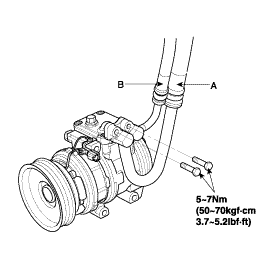
If the compressor is marginally operable, run the engine at idle speed, and let the air conditioning work for a few minutes, then shut the engine off.
Disconnect the negative cable from the battery.
Recover the refrigerant with a recovery/charging station (see page HA-23).
Loosen the drive belt (see page HA-26).
Remove the nuts, then disconnect the suction line (A) and discharge (B) line from the compressor.Plug or cap the lines immediately after disconnecting them to avoid moisture and dust contamination.

Disconnect the compressor clutch connector (A), then remove the mounting bolts and the compressor (B).

Using a hexagon wrench (6mm) remove the bolts, the manifold assembly (A) and the gasket (B) from the compressor.

Install in the reverse order of removal, and note these items.
If you're installing a new compressor, drain all the refrigerant oil from the removed compressor, and measure its volume, Subtract the volume of drained oil from 200ml the result is the amount of oil you should drain from the new compressor (through the suction fitting).
Replace the O-rings with new ones at each fitting, and apply a thin coat of refrigerant oil before installing them. Be sure to use the right O-rings for R-134a to avoid leakage.
To avoid contamination, do not return the oil to the container once dispensed, and never mix it with other refrigerant oils.
Immediately after using the oil, replace the cap on the container and seal it to avoid moisture absorption.
Do not spill the refrigerant oil on the vehicle; it may damage the paint; if the refrigerant oil contacts the paint, wash it off immediately.
Adjust the drive belt (see page HA-26).
Charge the system (see page HA-24), and test its performance (see page HA-22).
Check the plated parts of the pressure plate for color changes, peeling or other damage. If there is damage, replace the clutch set.
Check the pulley bearing play and drag by rotating the pulley by hand. Replace the clutch set with a new one if it is noisy or has excessive play/drag.
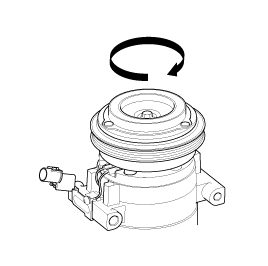
Measure the clearance between the pulley (A) and the pressure plate (B) all the way around. If the clearance is not within specified limits, remove the pressure plate (see page HA-34) and add or remove shims as needed to increase or decrease clearance.
Clearance : 0.5 ± 0.15mm (0.020 ± 0.006 in.)
The shims are available in seven thicknesses : 0.7mm, 0.8mm, 0.9mm, 1.0mm, 1.1mm, 1.2mm and 1.3mm.
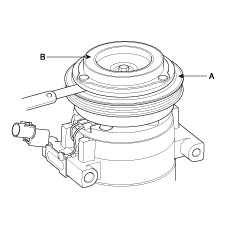
Check operating of the magnetic clutch.
Connect the compressor side terminals to the battery (+) terminal and the ground battery (-) terminal to the compressor body.
Check the magnetic clutch operating noise to determine the condition.

Remove the center bolt (A) while holding the pressure plate with a commercially available pressure plate bolt remover; Special tool number 09977-29000.
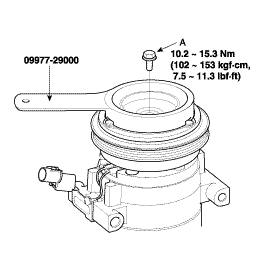
Remove the pressure plate (A) and shim (B), taking care not to lose the shims. If the clutch needs adjustment, increase or decrease the number and thickness of shims as necessary, then reinstall the pressure plate, and recheck its clearance (see page HA-33).

If you replacing the field coil, remove snap ring (A) with snap ring pliers.
Be careful not to damage the pulley (B) and compressor during remove/installation.
Once snap ring (A) is removed, replace it with a new one.

Remove the screw from the field coil ground terminal.
Remove the field coil (A) from the shaft with a puller (B). Be careful not to damage the coil and compressor.
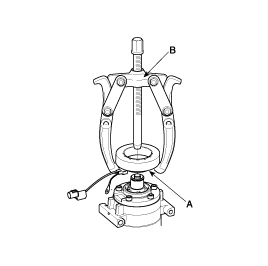
Reassemble the compressor clutch in the reverse order of disassembly, and note these items :
Clean the pulley and compressor sliding surfaces with non-petroleum solvent.
Install new snap rings, and make sure they are fully seated in the groove.
Make sure that the pulley turns smoothly after it's reassembled.